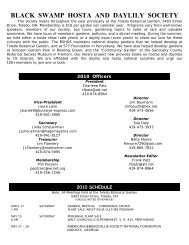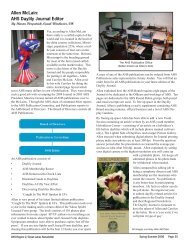Pages - AHS Region 2
Pages - AHS Region 2
Pages - AHS Region 2
You also want an ePaper? Increase the reach of your titles
YUMPU automatically turns print PDFs into web optimized ePapers that Google loves.
<strong>AHS</strong> <strong>Region</strong> 2/Great Lakes Newsletter<br />
Daylilies are beautiful flowers. Seemingly simple<br />
things, the plants are but a few arching green leaves<br />
and a straight, tall stem with which they hold their<br />
rainbow chalices high. Everyone knows where beautiful<br />
daylilies come from: “Pretty begets Pretty,” as testified<br />
by the folklore of daylilies. Surely, creating new<br />
daylilies must be a heavenly pursuit for innocent souls.<br />
Well, “innocent souls” may be a bit of a misstatement.<br />
The fables of daylilydom always seem to include in the<br />
fine print: “She ruthlessly discarded every plant that<br />
did not excel”! Hybridizers are in fact heartless and<br />
cruel.<br />
Now don’t look at me; I never get rid of those old seedlings<br />
until my wife threatens to hire a farmer to plow<br />
the whole garden under.<br />
A skilled, professional daylily hybridizer will probably<br />
keep somewhere between one seedling out of every 300<br />
to 3000 plants. This assumes that she or he has a reliable<br />
breeding line established. The rest of us should<br />
probably throw away 30,000 of our seedlings for every<br />
plant we keep and name.<br />
The Devil Is in the Details<br />
Let’s begin with diploid daylilies. Each cell in every<br />
diploid plant contains 22 chromosomes, which can sort<br />
themselves into 11 pairs. That is what is meant by the<br />
notation 2n = 22, because n = 11, the number of pairs.<br />
Each grain of pollen and each egg cell gets only one<br />
chromosome from each pair, so the chromosome<br />
complement of a pollen grain or an egg cell is just 11<br />
chromosomes, barring mishap.<br />
When you look at two diploids, the chromosomes work<br />
out like this:<br />
Parent I<br />
Parent II<br />
Pair 1 a, b c, d<br />
Pair 2 a, b c, d<br />
Pair 3 a, b c, d<br />
Pair 4 a, b c, d<br />
Pair 5 a, b c, d<br />
Pair 6 a, b c, d<br />
Pair 7 a, b c, d<br />
Pair 8 a, b c, d<br />
Pair 9 a, b c, d<br />
Pair 10 a, b c, d<br />
Pair 11 a, b c, d<br />
(This is not to imply that, for instance, any chromosome<br />
of pair 2 is the same as any chromosome of pair 3.)<br />
Page 14 Fall 2000/Winter 2001<br />
Iconoclast’s Corner<br />
Why Hybridizing Daylilies is Tric<br />
ricky<br />
By Jim Shields, Indiana<br />
The pollen grains and the Egg cells of the Parents can<br />
be any of these:<br />
a b b b … a<br />
a a b b … b<br />
a a a b … a<br />
a a a a … a<br />
a a a a … a<br />
a a a a … a<br />
a a a a … a<br />
a a a a … a<br />
a a a a … a<br />
a a a a … a<br />
a a a a … a<br />
Well, you get the idea. There are 2 11 possible pollen<br />
grains for one diploid daylily flower, which amounts to<br />
2,048 ways of assorting 11 pairs of the diploid genome<br />
into half-pairs or “haploid” sets. This is just the pollen<br />
parent! The pod parent has the same number of options,<br />
2,048. These numbers are multiplicative when<br />
you cross egg X pollen, so if you multiply 2,048 X 2,048<br />
you get about 4 million combinations. Actually, there<br />
are exactly 4,194,304 possible unique pairings of pollen<br />
with egg cell. To exhaust all the possibilities of a<br />
random diploid cross, you will need to grow at least<br />
one of each of those 4 million variations. This is assuming<br />
there are no chromosomal rearrangements,<br />
which probably is not going to be true among 4 million<br />
seedlings from the same parents. Mother Nature is a<br />
wily old devil.<br />
We should digress here into tetraploids for just a second,<br />
to illustrate why diploids are so much simpler to<br />
work with when you are looking at the genetics. There<br />
are 2 22 or 4,194,304 possible sets of unique pollen grains<br />
for a tetraploid daylily. There are 4,194,304 X 4,194,304<br />
= 1.76 X 10 13 (one “helluva” large number!) possible<br />
unique pollen + egg combinations for a tetraploid cross.<br />
In many tetraploid crosses, that number will be reduced<br />
because of redundancy in the chromosomes, but<br />
that’s a story for another day.<br />
Maybe we ought to go out and repeat that cross of IDA’S<br />
MAGIC x ADMIRAL’S BRAID one more time!<br />
The Color of Purple<br />
So you want to breed a good purple daylily, do you<br />
Great! All you have to do is figure out where “purple”<br />
comes from, put that into the pot, and fire it up.<br />
I will give you a hint to start with: purple color comes














